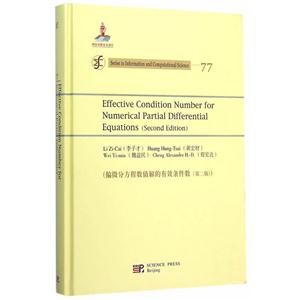偏微分方程数值解的有效条件数-(第二版)-英文

|
偏微分方程数值解的有效条件数-(第二版)-英文作者:李子才 开 本:16开 书号ISBN:9787030464101 定价:138.0 出版时间:2015-12-01 出版社:科学出版社 |
偏微分方程数值解的有效条件数-(第二版)-英文 本书特色
李子才、黄宏财、魏益民、程宏达编*的《偏微分方程数值解的有效条件数(第2版英文版)(精)》主要介绍偏微分方程数值解的有效条件数.首先介绍有效条件数的概念,与经典条件数概念的差异,接着将有效条件数运用于trefftz方法;我们还讨论了有限差分和有限元方法的有效条件数,*后研究了截断奇异值分解和tikhonov正则化的有效条件数.第二版拟增加三章:laplace方程混合边界值问题基本解的稳定性分析;奇摄动微分方程迎风差分格式的稳定性分析;广义sylvester方程的有效条件数。
偏微分方程数值解的有效条件数-(第二版)-英文 目录
preface to the second editionprefaceacknowledgementschapter 1 effective condition number 1.1 introduction 1.2 preliminary 1.3 symmetric matrices 1.3.1 definitions of effective condition numbers 1.3.2 a posteriori computation 1.4 overdetermined systems 1.4.1 basic algorithms 1.4.2 refinements of (1.4.10) 1.4.3 criteria 1.4.4 advanced refinements 1.4.5 effective condition number in p-norms 1.5 linear algebraic equations by ge or qr 1.6 application to numerical pde 1.7 application to boundary integral equations 1.8 weighted linear least squares problems 1.8.1 effective condition number 1.8.2 perturbation bounds 1.8.3 applications and comparisonschapter 2 collocation trefftz methods 2.1 introduction 2.2 ctm for motz's problem 2.3 bounds of effective condition number 2.4 stability for ctm of rp = 1 2.5 numerical experiments 2.5.1 choice of rp 2.5.2 extreme accuracy of do 2.6 the gctm using piecewise particular solutions 2.7 stability analysis of the gctm 2.7.1 trefftz methods 2.7.2 collocation trefftz methods 2.8 method of fundamental solutions 2.9 collocation methods using rbf 2.10 comparisons between cond_eff and cond 2.10.1 the ctm using particular solutions for motz's problem 2.10.2 the mfs and the cm-rbf 2.11 a few remarkschapter 3 simplified hybrid trefftz methods 3.1 the simplified hybrid tm 3.1.1 algorithms 3.1.2 error analysis 3.1.3 integration approximation 3.2 stability analysis for simplified hybrid tmchapter 4 penalty trefftz method coupled with fem 4.1 introduction 4.2 combinations of tm and adini's elements 4.2.1 algorithms 4.2.2 basic theorem 4.2.3 global superconvergence 4.3 bounds of cond_eff for motz's problem 4.4 effective condition number of one and infinity norms 4.5 concluding remarkschapter 5 trefftz methods for biharmonic equations with crack singularities 5.1 introduction 5.2 collocation trefftz methods 5.2.1 three crack models 5.2.2 description of the method 5.2.3 error bounds 5.3 stability analysis 5.3.1 upper bound for σmax(f) 5.3.2 lower bound for σmin(f) 5.3.3 upper bound for cond_eff and cond 5.4 proofs of important results used in section 5.3 5.4.1 basic theorem 5.4.2 proof of lemma 5.4.3 5.4.3 proof of lemma 5.4.4 5.5 numerical experiments 5.6 concluding remarkschapter 6 the method of fundamental solutions for mixed boundary value problems of laplace's equation 6.1 introduction 6.2 method of fundamental solutions 6.3 dirichlet problems on disk domains 6.3.1 eigenvalues of the mfs 6.3.2 new approaches 6.3.3 eigenvalues in terms of power series 6.3.4 asymptotes of cond 6.4 neumann problems in disk domains 6.4.1 description of algorithms 6.4.2 condition numbers of the mfs 6.5 mixed boundary problems in bounded simply-connected domains 6.5.1 trefftz methods 6.5.2 the collocation trefftz methods 6.5.3 bounds of condition numbers and effective condition numbers 6.5.4 developments and evaluations on the mfs 6.5.5 the inverse inequality (6.5.9) 6.6 numerical experimentschapter 7 finite difference method 7.1 introduction 7.2 shortley-weller difference approximation 7.2.1 a lemma 7.2.2 bounds for cond_ee 7.2.3 bounds for cond_effchapter 8 boundary penalty techniques of fdm 8.1 introduction 8.2 finite difference method 8.2.1 shortley-weller difference approximation 8.2.2 superconvergence of solution derivatives 8.2.3 bounds for cond_eff 8.3 penalty-integral techniques 8.4 penalty-collocation techniques 8.5 relations between penalty-integral and penalty- collocation techniques 8.6 concluding remarkschapter 9 boundary singularly problems by fdm 9.1 introduction 9.2 finite difference method 9.3 local refinements of difference grids 9.3.1 basic results 9.3.2 nonhomogeneous dirichlet and neumann boundary conditions .. 9.3.3 a remark 9.3.4 a view on assumptions a1-a4 9.3.5 discussions and comparisons 9.4 numerical experiments 9.5 concluding remarkschapter 10 singularly perturbed differential equations by the upwind difference scheme 10.1 introduction 10.2 the upwind difference scheme 10.3 properties of the operator of spde and its discretization 10.4 stability analysis 10.4.1 the traditional condition number 10.4.2 effective condition number 10.4.3 via the maximum principle 10.5 numerical experiments and concluding remarkschapter 11 finite element method using local mesh refinements 11.1 introduction 11.2 optimal convergence rates 11.3 homogeneous boundary conditions 11.4 nonhomogeneous boundary conditions 11.5 intrinsic view of assumption a2 and improvements of theorem 11.4.1 11.5.1 intrinsic view of assumption a2 11.5.2 improvements of theorem 11.4.1 11.6 numerical experimentschapter 12 hermite fem for biharmonic equations 12.1 introduction 12.2 description of numerical methods 12.3 stability analysis 12.3.1 bounds of cond 12.3.2 bounds of cond_eff 12.4 numerical experimentschapter 13 truncated svd and tikhonov regularization 13.1 introduction 13.2 algorithms of regularization 13.3 new estimates of cond and cond_eff 13.4 brief error analysischapter 14 small sample statistical condition estimation for the generalized sylvester equation 14.1 introduction 14.2 effective condition numbers 14.3 small sample statistical condition estimation 14.3.1 normwise perturbation analysis 14.3.2 mixed and componentwise perturbation analysis 14.4 numerical examples 14.5 concluding remarksappendix a definitions and formulas a.1 square systems a.i.1 symmetric and positive definite matrices a.1.2 symmetric and nonsingular matrices a.1.3 nonsingular matrices a.2 overdetermined systems a.3 underdetermined systems a.4 method of fundamental solutions a.5 regularization a.5.1 the truncated singular value decomposition a.5.2 the tikhonov regularization a.6 p-norms a.7 conclusionsepiloguebibliographyindex
自然科学 数学 微积分
在线阅读
- 最新内容
- 相关内容
- 网友推荐
- 图文推荐
上一篇:分数阶偏微分方程数值方法及其应用
下一篇:水沙水质类水利工程问题数值模拟理论与应用
零零教育社区:论坛热帖子
| [高考] 2022 西安电子科技大学《软件工程》大作业答案 (2022-04-25) |
| [家长教育] 孩子为什么会和父母感情疏离? (2019-07-14) |
| [教师分享] 给远方姐姐的一封信 (2018-11-07) |
| [教师分享] 伸缩门 (2018-11-07) |
| [教师分享] 回家乡 (2018-11-07) |
| [教师分享] 是风味也是人间 (2018-11-07) |
| [教师分享] 一句格言的启示 (2018-11-07) |
| [教师分享] 无规矩不成方圆 (2018-11-07) |
| [教师分享] 第十届全国教育名家论坛有感(二) (2018-11-07) |
| [教师分享] 贪玩的小狗 (2018-11-07) |






